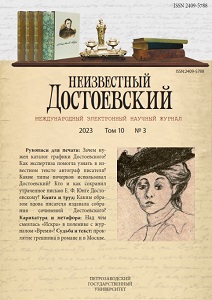Сколько почерков у Достоевского: задачи типологии
How Many Handwritings Does Dostoevsky Have: Typology Tasks
Author(s): Vladimir Nikolaevich ZakharovSubject(s): Semiotics / Semiology, Historical Linguistics, Russian Literature, 19th Century
Published by: Петрозаводский государственный университет
Keywords: Dostoevsky; textual criticism; type; typology; handwriting; correct cursive; cursive; calligraphy;
Summary/Abstract: Dostoevsky’s handwriting has only recently become the subject of special research. This was facilitated by a number of tasks of studying the manuscript corpus of Dostoevsky’s texts. Modern scholars often do not entirely know the grammar and graphics of the writer. A significant volume of Dostoevsky’s manuscripts is written in illegible cursive. It is not always possible for researchers to confidently determine who created the handwritten text — the author or the scribe. In many cases, there is no relatively accurate printed reproduction of manuscripts. Some of the complex texts were read mistakenly. The use of digital technologies allows us to solve some of the research tasks. One of the auxiliary tasks is to study the typology of Dostoevsky’s handwriting. By the 19th century, such common types of handwriting as correct cursive, cursive and calligraphy had historically developed in Russia. There are different definitions of these concepts, but their meaning is most precisely explained by the semantics of words. The correct cursive reproduces the outlines of letters and words according to samples. Everyone learned to write properly according to cursive workbooks, but everyone had their own handwriting. In life, a person usually managed with one handwriting, as a rule, cursive. Tachygraphic writing is functional. Its task is to simplify the spelling of letters and speed up the writing process. Regular tachygraphic writing is legible, but rapid tachygraphic writing is not always legible. Calligraphy is often equated with correct cursive, but it was penmanship that was taught in cursive copybooks — beautiful handwriting according to the prescribed samples is dead. Dostoevsky wrote not by craft, but by inspiration, out of love for art. Patterns are excluded in Dostoevsky’s calligraphy — it’s all about personal skill. It is enough to recall the multiplication of calligraphies by Myshkin in the novel “The Idiot.” Dostoevsky adds four more original calligraphies to the five famous ones through Myshkin’s words. There is no such analysis in research literature. Dostoevsky aspired to a variety of handwritings. In his understanding, the letter expressed the spirit, the national character of a person and people, the meaning of speech and words. It is necessary to detail the types of Dostoevsky’s handwriting.
Journal: Неизвестный Достоевский
- Issue Year: 10/2023
- Issue No: 3
- Page Range: 42-62
- Page Count: 21
- Language: Russian

